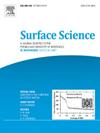贵金属(Ag, Au, Pt, Pd)掺杂单层SnSe2吸附气体分子CO
IF 1.8
4区 化学
Q3 CHEMISTRY, PHYSICAL
引用次数: 0
摘要
利用第一性原理研究了高活性稳定的贵金属(Ag、Au、Pt、Pd)原子掺杂对SnSe2单层吸附CO气体分子的影响,有效提高了SnSe2单层对有害气体的敏感性。CO在结构表面最稳定的吸附构型是靠近晶体表面、微倾斜、垂直于六边形空位顶部的C原子吸附。随着贵金属原子的包埋,CO在体系表面的吸附高度和吸附能降低,CO在体系表面的结合增强,SnSe2体系的吸附性能得到提高。声子色散分析表明,所有体系都能稳定形成。Au和Ag原子的引入使整个吸附体系金属化。掺杂原子的d轨道电子增强了Sn-4p和Se-4s轨道之间的杂化,加强了电子相互作用。Mulliken居群分析表明,当掺杂体系表面吸收CO分子时,CO分子进行转移的电荷数量增加,体系的表面活性增强。本文章由计算机程序翻译,如有差异,请以英文原文为准。
Precious metal (Ag, Au, Pt, Pd) doped monolayer SnSe2 adsorption of gas molecules CO
The effect of atomic doping of noble metals (Ag, Au, Pt, Pd) with high activity and stability on the adsorption of CO gas molecules by monolayers of SnSe2 is investigated by using the first principles, which is used to effectively improve the sensitivity of monolayers of SnSe2 to harmful gases. The most stable adsorption configuration of CO on the surface of the structure was found to be adsorbed with C atoms close to the crystal surface, slightly tilted, and perpendicular to the top of the hexagonal vacancies. With the embedding of noble metal atoms, the adsorption height and adsorption energy of CO on the system's surface decreased, the binding of CO on the system's surface increased, and the adsorption performance of the SnSe2 system was improved. The phonon dispersion analysis shows that all systems can be formed stably. The introduction of Au and Ag atoms makes the whole adsorption system metallic. The d-orbital electrons of dopant atoms enhance hybridization between Sn-4p and Se-4s orbitals, strengthening electronic interactions. Mulliken populations analysis shows that the number of charges for CO molecules to undergo transfer increases when the surface of the doped system absorbs CO molecules, and the surface activity of the system is enhanced.
求助全文
通过发布文献求助,成功后即可免费获取论文全文。
去求助
来源期刊

Surface Science
化学-物理:凝聚态物理
CiteScore
3.30
自引率
5.30%
发文量
137
审稿时长
25 days
期刊介绍:
Surface Science is devoted to elucidating the fundamental aspects of chemistry and physics occurring at a wide range of surfaces and interfaces and to disseminating this knowledge fast. The journal welcomes a broad spectrum of topics, including but not limited to:
• model systems (e.g. in Ultra High Vacuum) under well-controlled reactive conditions
• nanoscale science and engineering, including manipulation of matter at the atomic/molecular scale and assembly phenomena
• reactivity of surfaces as related to various applied areas including heterogeneous catalysis, chemistry at electrified interfaces, and semiconductors functionalization
• phenomena at interfaces relevant to energy storage and conversion, and fuels production and utilization
• surface reactivity for environmental protection and pollution remediation
• interactions at surfaces of soft matter, including polymers and biomaterials.
Both experimental and theoretical work, including modeling, is within the scope of the journal. Work published in Surface Science reaches a wide readership, from chemistry and physics to biology and materials science and engineering, providing an excellent forum for cross-fertilization of ideas and broad dissemination of scientific discoveries.
 求助内容:
求助内容: 应助结果提醒方式:
应助结果提醒方式:


